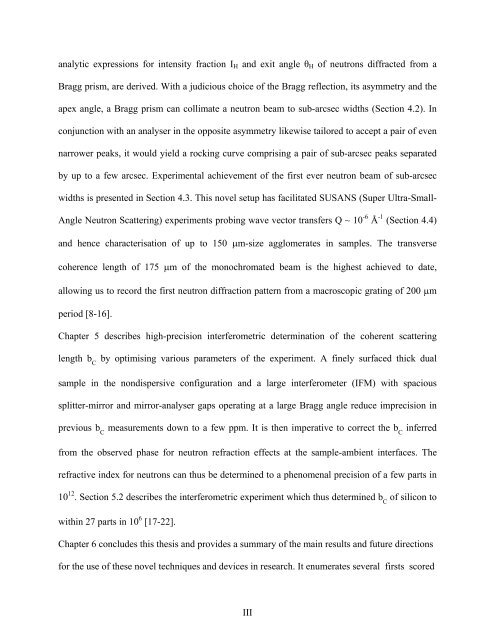PHYS01200804001 Sohrab Abbas - Homi Bhabha National Institute
PHYS01200804001 Sohrab Abbas - Homi Bhabha National Institute
PHYS01200804001 Sohrab Abbas - Homi Bhabha National Institute
Create successful ePaper yourself
Turn your PDF publications into a flip-book with our unique Google optimized e-Paper software.
analytic expressions for intensity fraction I H and exit angle θ H of neutrons diffracted from a<br />
Bragg prism, are derived. With a judicious choice of the Bragg reflection, its asymmetry and the<br />
apex angle, a Bragg prism can collimate a neutron beam to sub-arcsec widths (Section 4.2). In<br />
conjunction with an analyser in the opposite asymmetry likewise tailored to accept a pair of even<br />
narrower peaks, it would yield a rocking curve comprising a pair of sub-arcsec peaks separated<br />
by up to a few arcsec. Experimental achievement of the first ever neutron beam of sub-arcsec<br />
widths is presented in Section 4.3. This novel setup has facilitated SUSANS (Super Ultra-Small-<br />
Angle Neutron Scattering) experiments probing wave vector transfers Q ~ 10 -6 Å -1 (Section 4.4)<br />
and hence characterisation of up to 150 μm-size agglomerates in samples. The transverse<br />
coherence length of 175 μm of the monochromated beam is the highest achieved to date,<br />
allowing us to record the first neutron diffraction pattern from a macroscopic grating of 200 μm<br />
period [8-16].<br />
Chapter 5 describes high-precision interferometric determination of the coherent scattering<br />
length b C<br />
by optimising various parameters of the experiment. A finely surfaced thick dual<br />
sample in the nondispersive configuration and a large interferometer (IFM) with spacious<br />
splitter-mirror and mirror-analyser gaps operating at a large Bragg angle reduce imprecision in<br />
previous b C<br />
measurements down to a few ppm. It is then imperative to correct the b inferred<br />
C<br />
from the observed phase for neutron refraction effects at the sample-ambient interfaces. The<br />
refractive index for neutrons can thus be determined to a phenomenal precision of a few parts in<br />
10 12 . Section 5.2 describes the interferometric experiment which thus determined b C<br />
of silicon to<br />
within 27 parts in 10 6 [17-22].<br />
Chapter 6 concludes this thesis and provides a summary of the main results and future directions<br />
for the use of these novel techniques and devices in research. It enumerates several firsts scored<br />
III
















